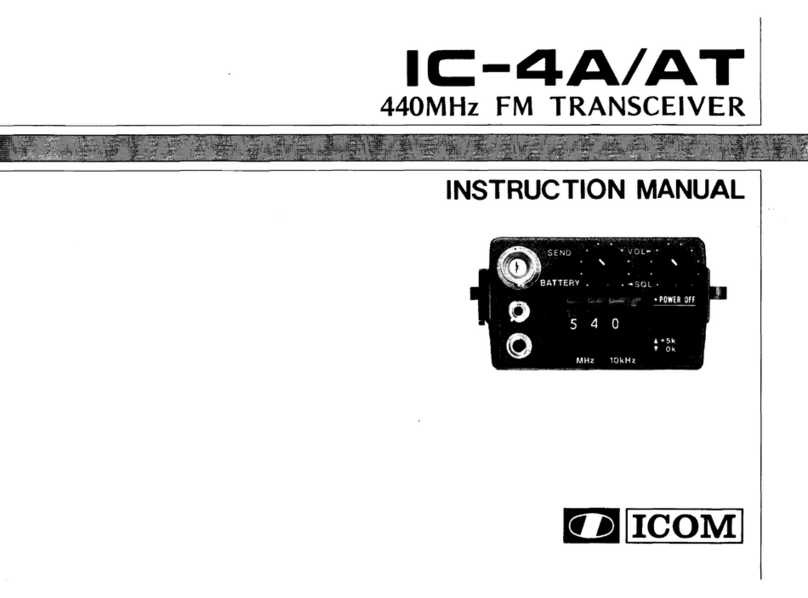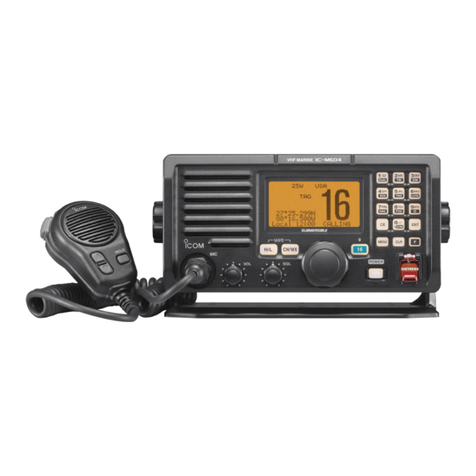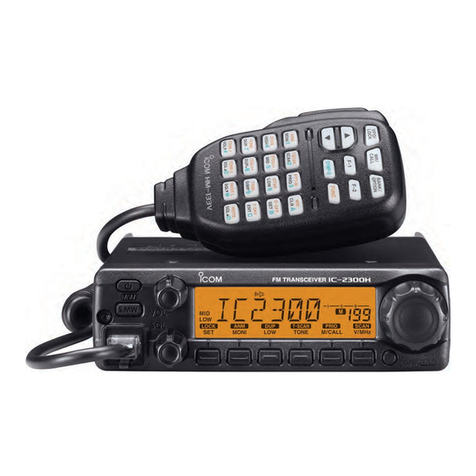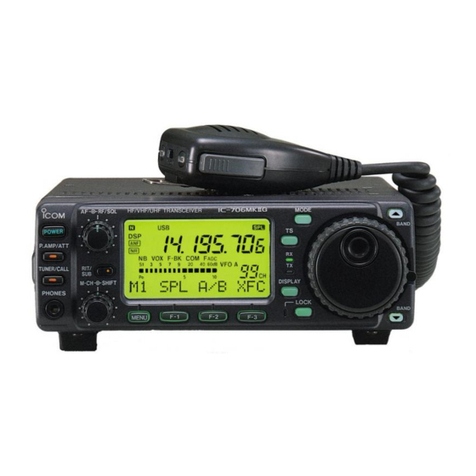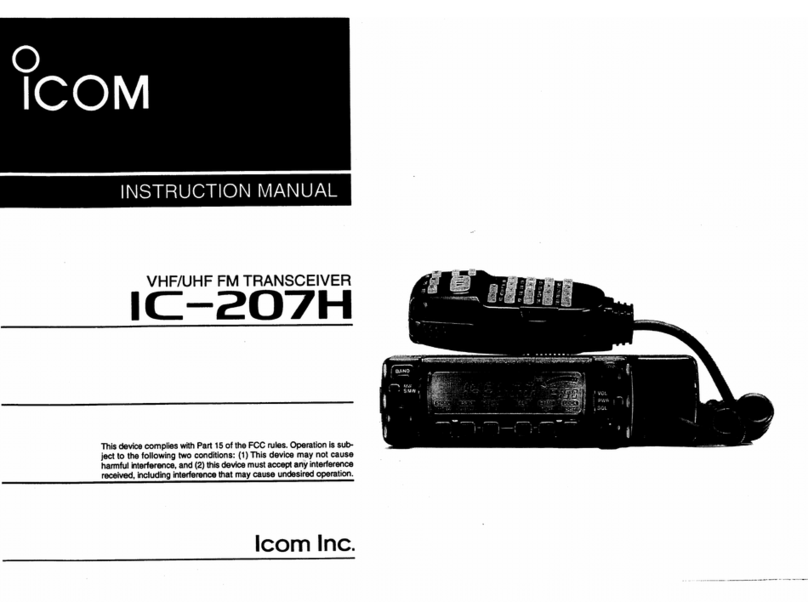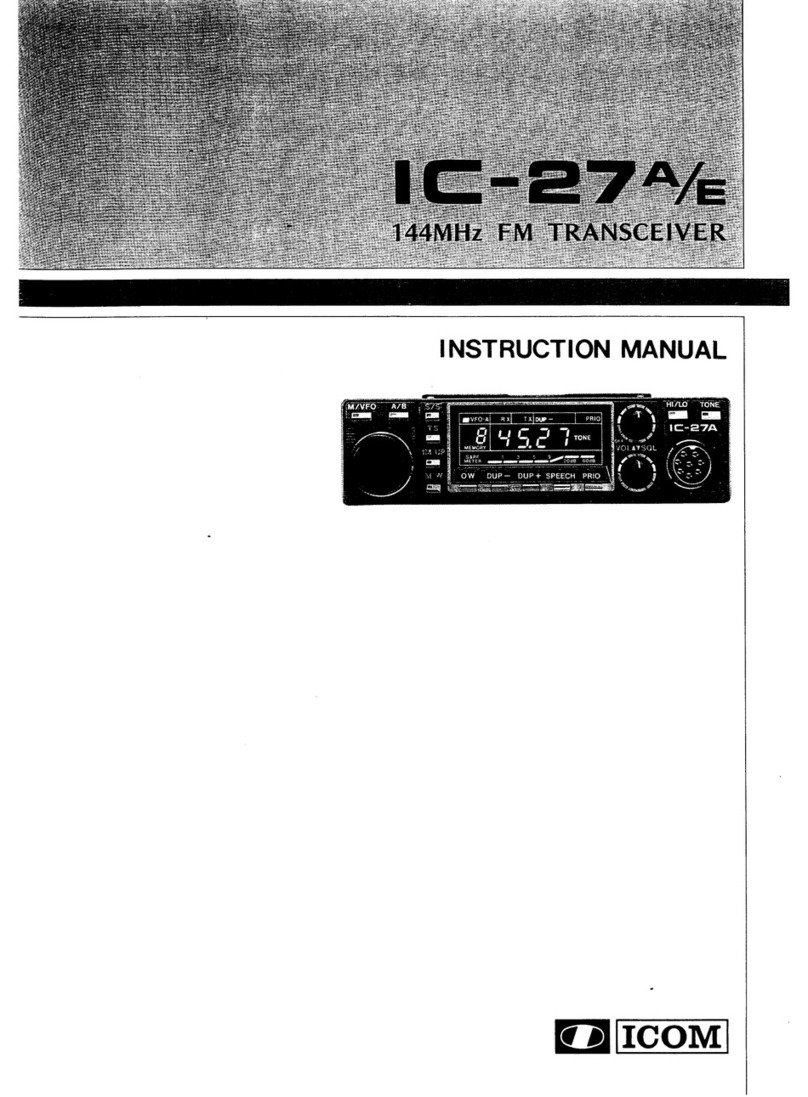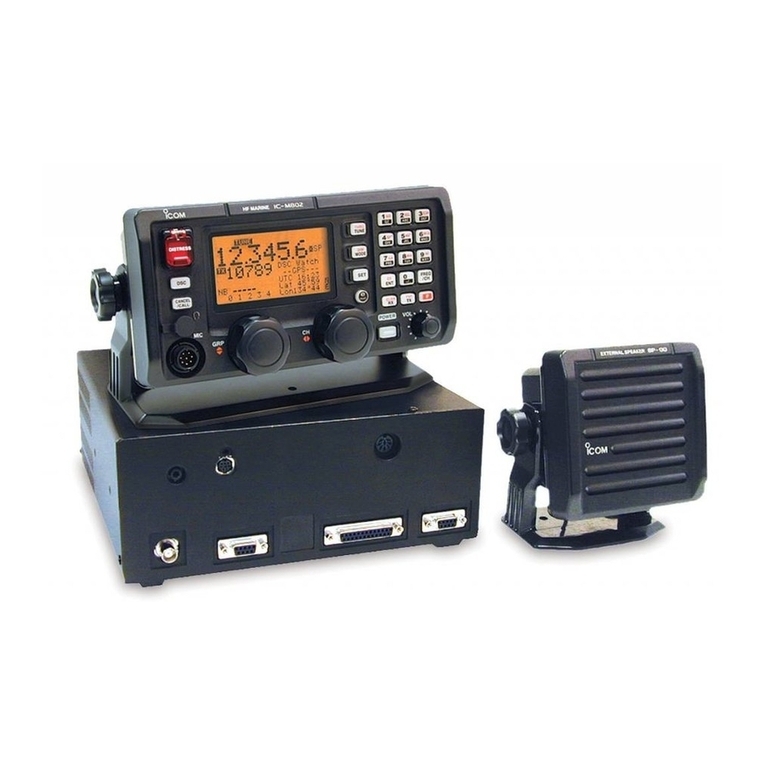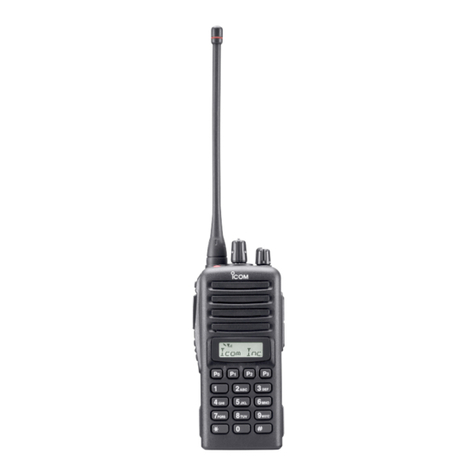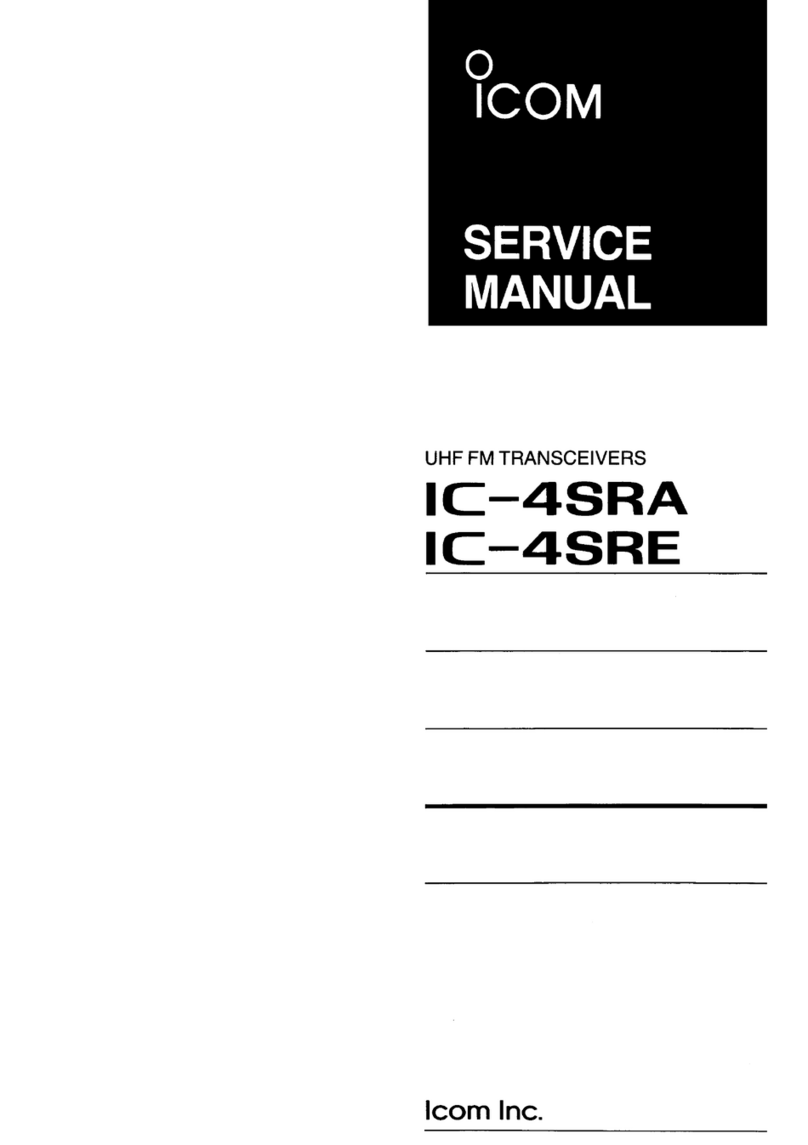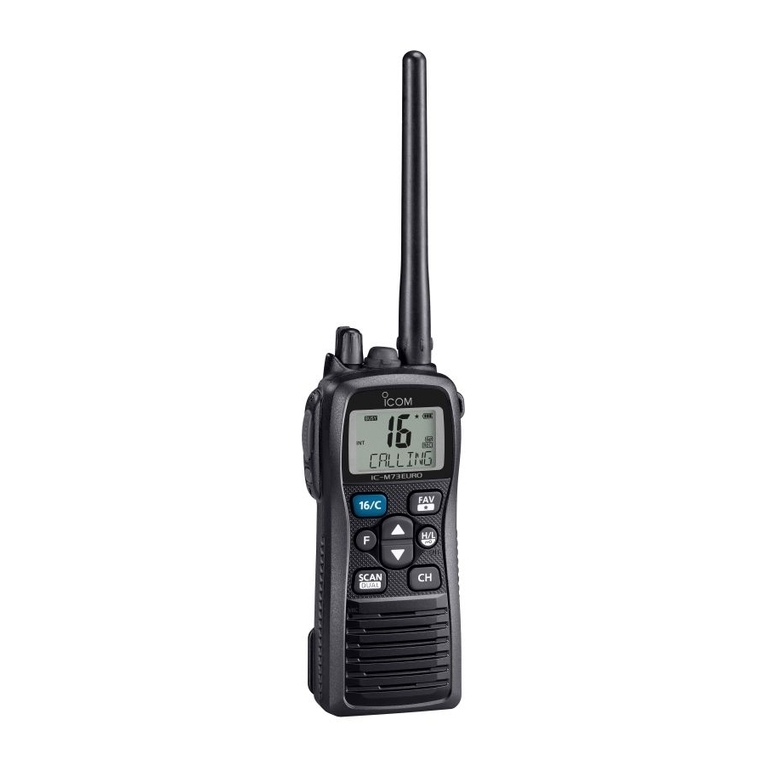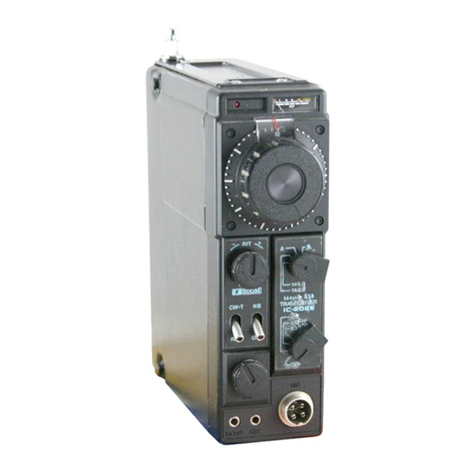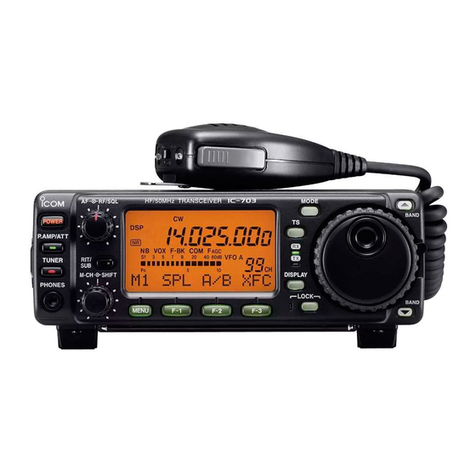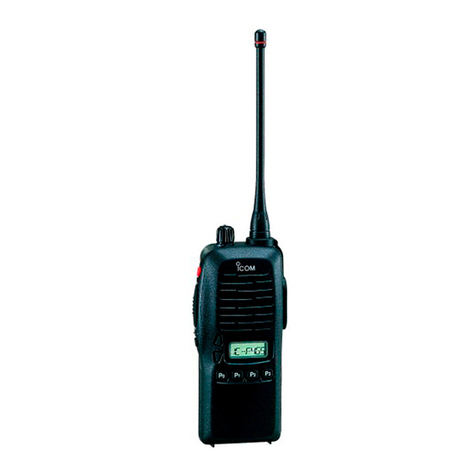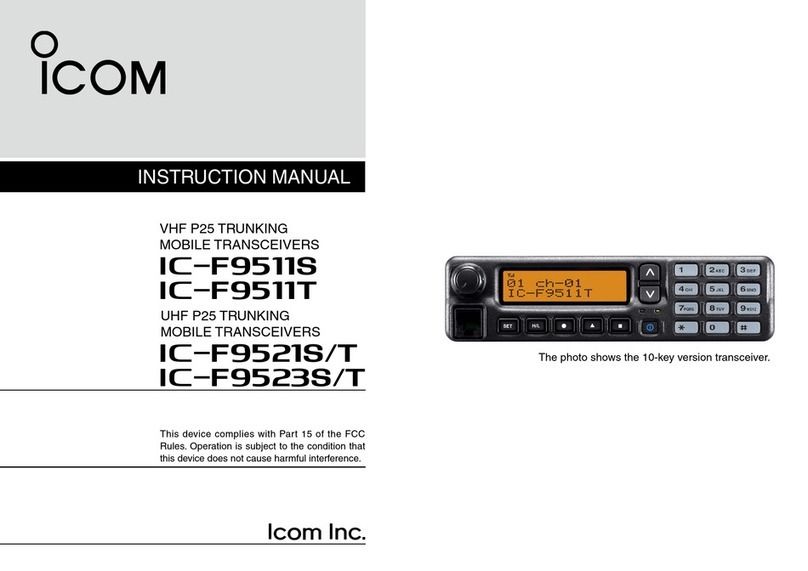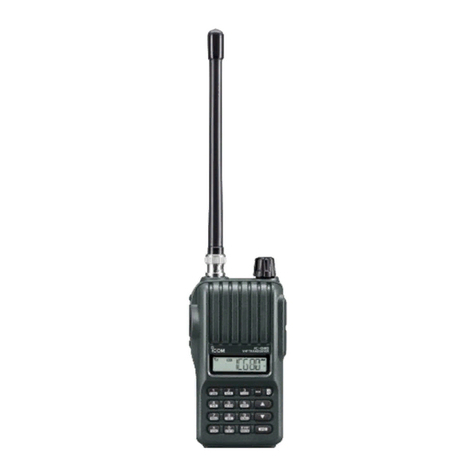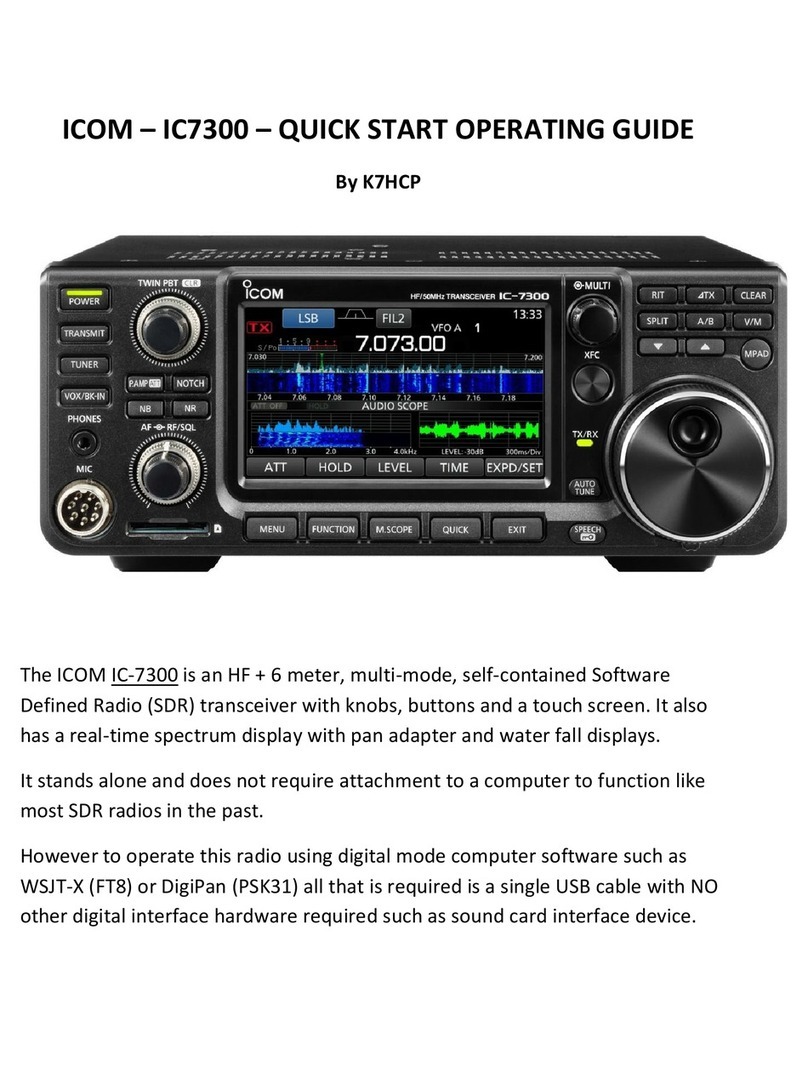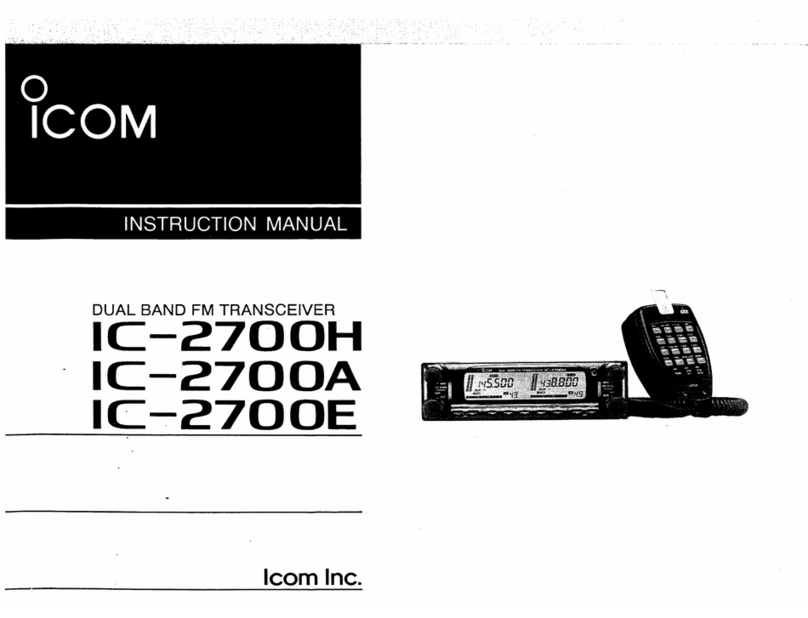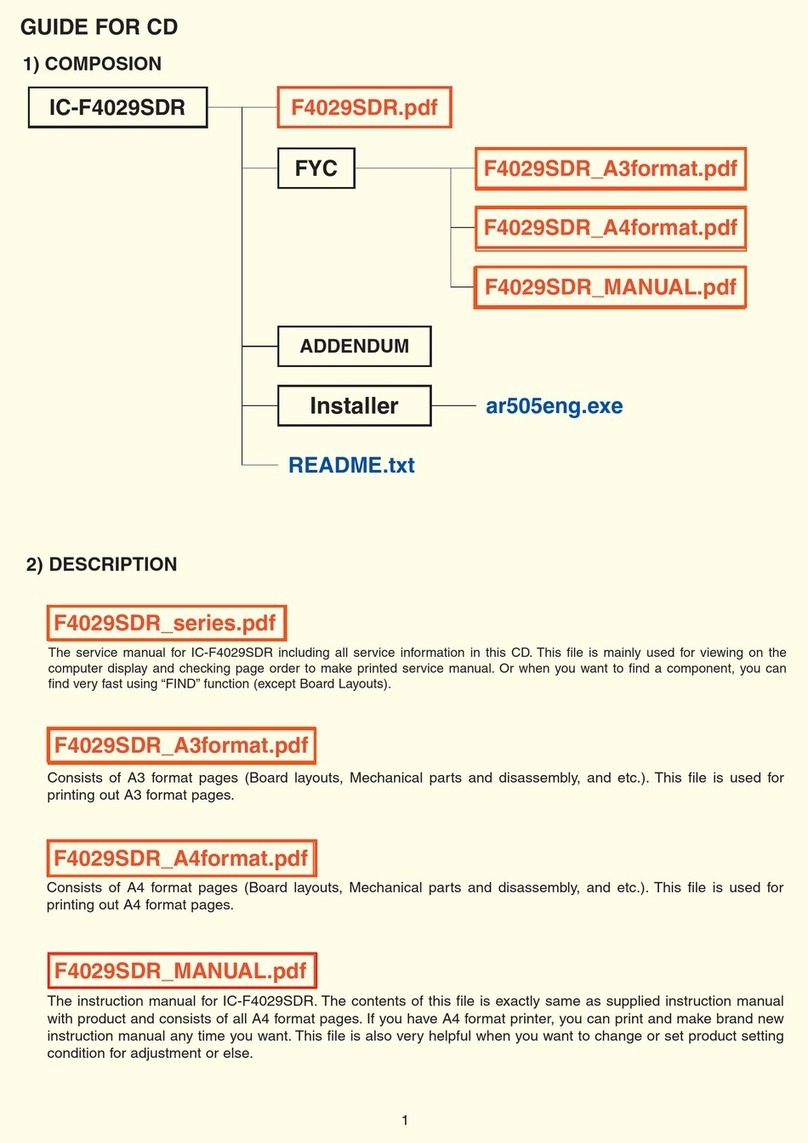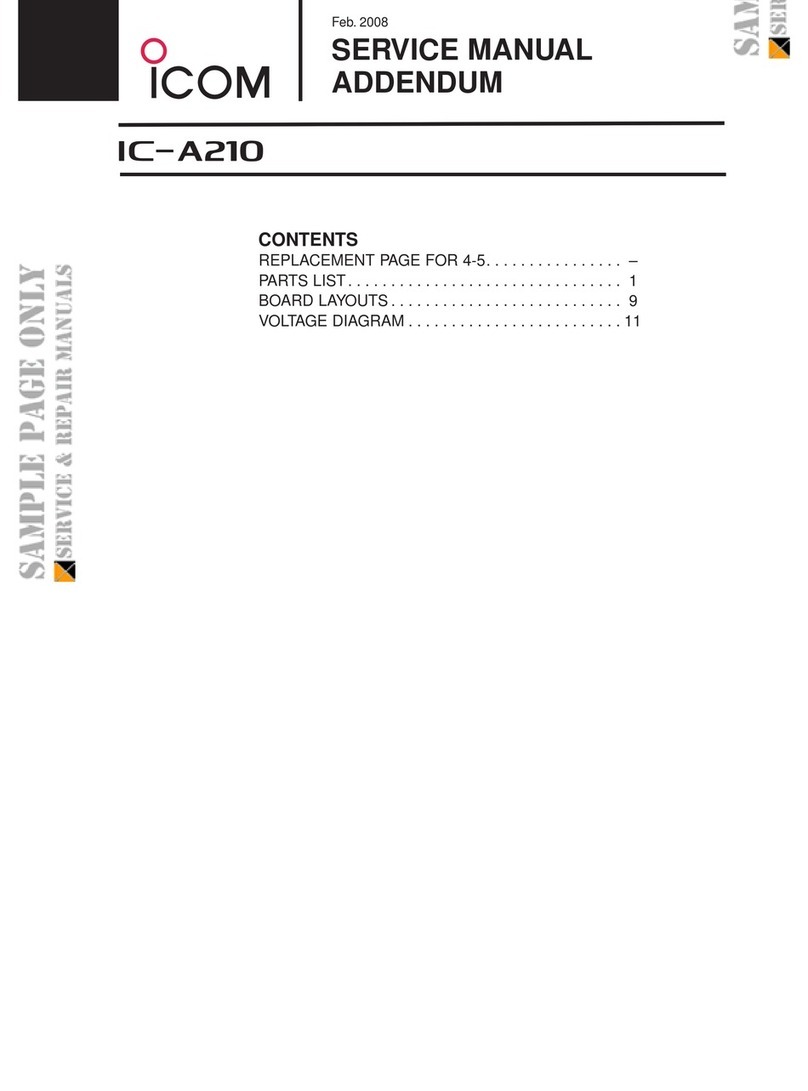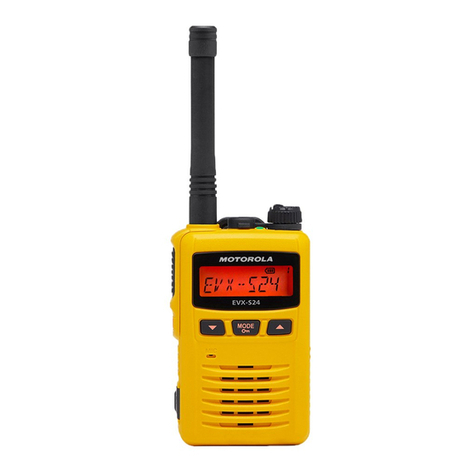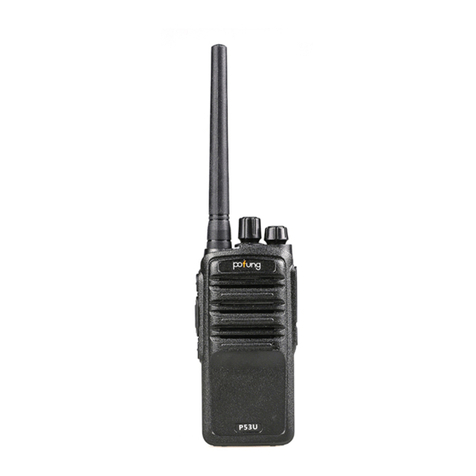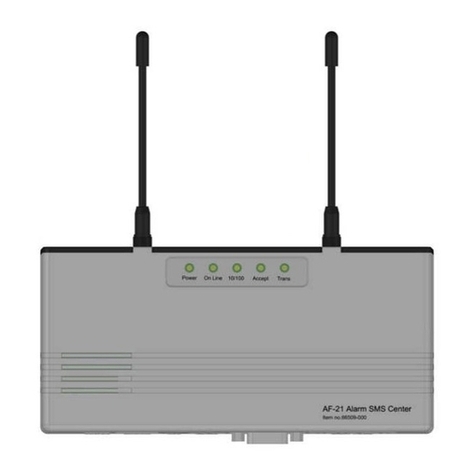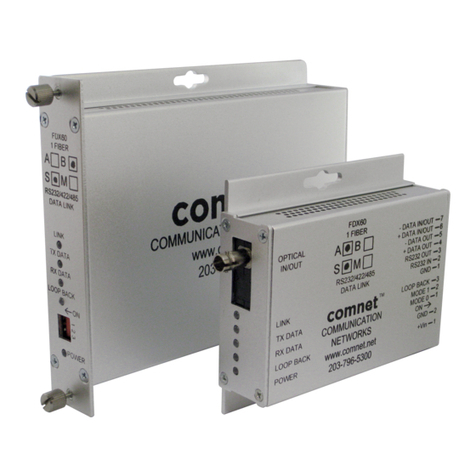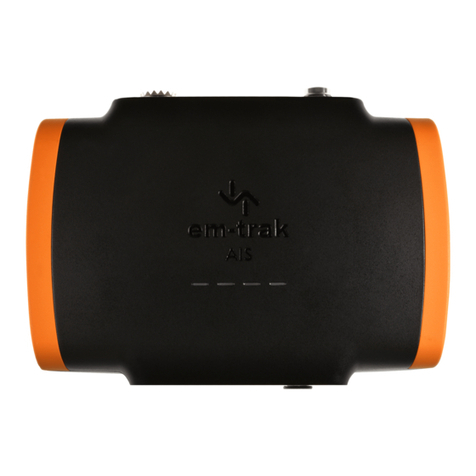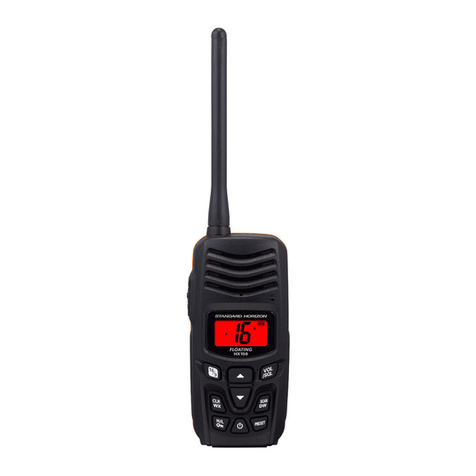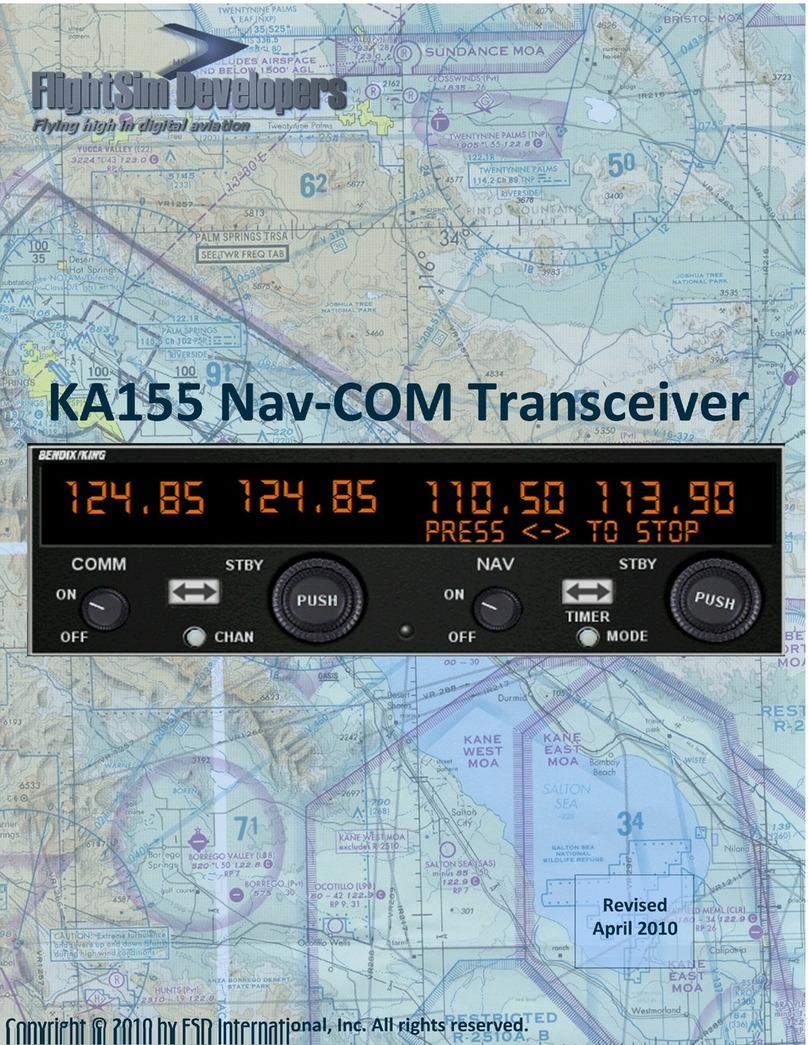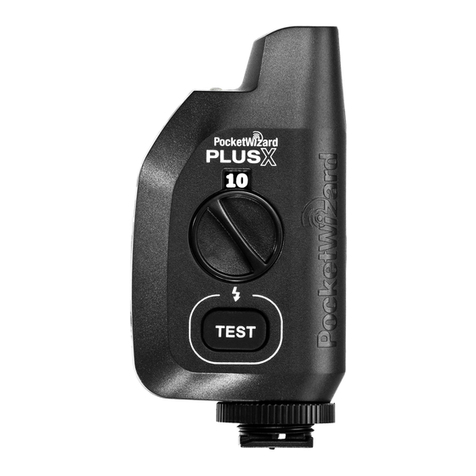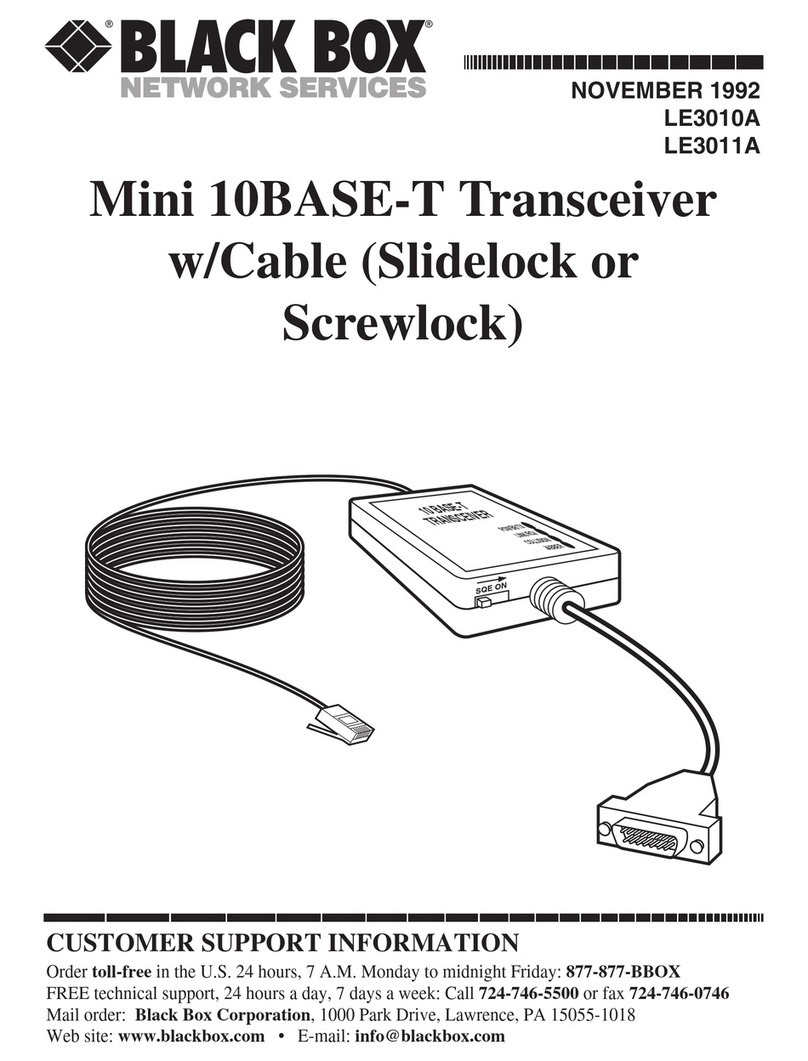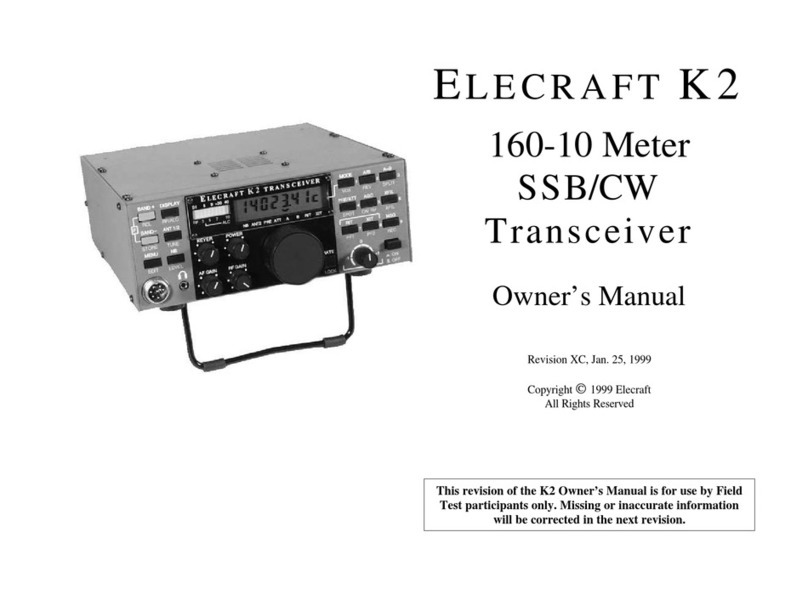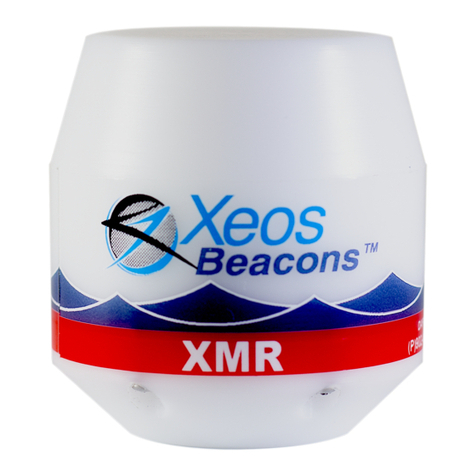Icom IC-450 User manual

INSTRUCTION MANUAL
i450
UHF TRANSCEIVER

i
IMPORTANT
READ ALL INSTRUCTIONS carefully before
using the IC-450 UHF TRANSCEIVER.
KEEP THIS INSTRUCTION MANUAL, as it
contains important operating information that may be useful
in the future.
EXPLICIT DEFINITIONS
WORD DEFINITION
RDANGER! Personal death, serious injury or an explo-
sion may occur.
RWARNING! Personal injury, fire hazard or electric
shock may occur.
CAUTION Equipment damage may occur.
NOTE
If disregarded, inconvenience only. No risk
of personal injury, fire or electric shock.
OPERATIONAL NOTES
i. The use of the citizen band radio service is licenced in
Australia by the ACMA Radiocommunications (Citizens
Band Radio Stations) Class Licence and in New Zealand
by the Ministry of Economic Development (MED) General
User Radio Licence for Citizen Band Radio and operation
is subject to conditions contained within these licences.
ii. Always listen on a channel (or observe the channel busy
indicator) to ensure it is not already being used before
transmitting.
iii. In Australia, channel 11 is the customary calling channel
for establishing communication. Channel 40 is the
customary road vehicle channel.
iv.
In Australia, except in an emergency, a CB transmitter
shall not be operated on UHF emergency channels 5 and
35.
v. No voice transmissions are permitted on data channels
22 and 23 (voice operation is inhibited on these
channels).
vi. The user of this UHF CB communications device shall
not transmit Selcall tones for longer than 3 seconds
during any 60 second period.
Icom, Icom Inc. and Icom logo are registered trademarks of Icom Incorporated
(Japan) in Japan, the United States, the United Kingdom, Germany, France,
Spain, Russia, Australia, New Zealand, and/or other countries.

ii
PRECAUTIONS
RWARNING! NEVER connect the radio to an AC
outlet. This may pose a fire hazard or result in an electric shock.
CAUTION: NEVER operate or touch the radio and
microphone with wet hands. This may result in an electric
shock or damage the radio and microphone.
CAUTION: NEVER connect the radio to a power
source of more than 27.6 V DC. This will damage the radio.
CAUTION: NEVER connect the radio to a power
source using reverse polarity. This will damage the radio.
CAUTION: NEVER cut the DC power cable between
the DC plug and fuse holder. If an incorrect connection is
made after cutting, the radio may be damaged.
CAUTION: NEVER expose the radio and microphone
to rain, snow or any liquids. The radio and microphone may
be damaged.
CAUTION: NEVER place the radio where normal
operation of the vehicle may be hindered or where it could
cause bodily injury.
DO NOT push the PTT when not actually intending to transmit.
DO NOT allow children to play with any radio equipment
containing a transmitter.
OPERATIONAL NOTES
vii. UHF CB repeaters extend the operational range of
your radio. Repeaters operate utilising two channels
(repeater input/repeater output). It is important to avoid
operation on locally used repeater input channels (in the
channel range of 31 to 38 and 71 to 78) or locally used
repeater output channels (in the channel range of 1 to 8
and 41 to 48), unless long distance communication via
the repeater is specifically required. See the section on
repeater operation for more information.
viii. Please be aware that the UHF CB network may
experience possible operational issues during the
changeover to narrowband. This transceiver operates
on 12.5 kHz channel spacing. During the changeover
period from 25 kHz to 12.5 kHz spacing, there may be
some loss of quality when 12.5 kHz (narrowband, 2.5
kHz deviation) transmissions are received on 25 kHz
(wide band, 5.0 kHz deviation) equipment, and vice-
versa. There may also be interference due to older
equipment being operated on channels adjacent to new
narrowband channels, as the channel setting on these
may cause some ‘overlap’. A list of currently authorised
channels can be found on the ACMA website (Australia)
and on the MED website in New Zealand.

iii
PRECAUTIONS (Continued)
DO NOT operate the radio near unshielded electrical
blasting caps or in an explosive atmosphere.
DO NOT operate the radio for extended periods
without running the vehicle’s engine. The radio’s power
consumption may soon exhaust the vehicles battery.
DO NOT set the radio in a place without adequate
ventilation. Heat dissipation may be affected, and the radio
may be damaged.
DO NOT use harsh solvents such as benzine or alcohol
to clean the radio, as they will damage the radio’s surfaces.
If the radio becomes dusty or dirty, wipe it clean with a soft,
dry cloth.
USE Icom microphones only (supplied or optional). Other
manufacturer’s microphones have different pin assignments
and may damage the radio if attached.
DO NOT modify the radio. The radio warranty does not
cover any problems caused by unauthorized modification.
DO NOT use or place the radio in direct sunlight or in
areas with temperatures below –10°C or above +60°C. The
basic operations, transmission and reception of the radio
are guaranteed within the specified operating temperature
range. However, the LCD display may not operate correctly,
or show an indication in the case of long hours of operation,
or after being placed in extremely hot or cold areas.
BE CAREFUL! The radio will become hot when
operating it continuously for long periods of time.
MAKE SURE to turn OFF the radio power before
connecting any supplied/optional equipment.
This device complies with Standard
Australia Specification No. AS/NZS 4365-
2011.

iv
TABLE OF CONTENTS
IMPORTANT.......................................................................... i
EXPLICIT DEFINITIONS....................................................... i
OPERATIONAL NOTES ........................................................ i
PRECAUTIONS.................................................................... ii
TABLE OF CONTENTS....................................................... iv
1 ACCESSORIES AND INSTALLATION .......................1–5
Supplied accessories■...................................................1
Installation and Connection■..........................................1
2 UNIT DESCRIPTION ...................................................6–9
Front and rear panels■...................................................6
HM■-212 Description .....................................................7
Display■.........................................................................8
3 BASIC OPERATION................................................10–15
Turning power ON■......................................................10
Adjusting the v■olume..................................................10
Selecting a c■hannel....................................................10
Receiving and transmitting■.........................................11
Priority channel■..........................................................13
Monitor■.......................................................................14
Lock■............................................................................14
Adjusting the squelch level■.........................................14
Backlight■.....................................................................15
Voice recorder■............................................................15
4 SET MODE ..............................................................16–19
Set mode■....................................................................16
SET mode items■........................................................17
5 REPEATER OPERATION..............................................20
Repeater operation■....................................................20
6 SCAN.......................................................................21–25
Scan types■.................................................................21
Scanning preparation■.................................................22
Open scan■..................................................................23
Group scan and priority scan■.....................................24
Repeater search scan■................................................25
7 TONE SQUELCH AND POCKET BEEP .................26–27
Tone squelch■..............................................................26
Pocket beep■...............................................................27
8 SELCALL (Selective Calling) ................................28–31
Calling■........................................................................28
Receiving■...................................................................30
Quiet mode■................................................................31
Stun■............................................................................31

v
9 OTHER FUNCTIONS...............................................32–34
Smart Ring and ATS■..................................................32
RX frequency (for only RX channels)■.........................33
Data cloning■...............................................................34
All reset■......................................................................34
10 SPECIFICATIONS AND OPTIONS .........................35–36
Specifications■.............................................................35
Options■.......................................................................36
11 MAINTENANCE ......................................................37–38
Troubleshooting■..........................................................37
Fuse replacement■......................................................38
12 WARRANTY AND REGISTRATION..............................39
INDEX...........................................................................47–49
TABLE OF CONTENTS (Continued)

1
1
ACCESSORIES AND INSTALLATION
11
■Supplied accessories
qDC power cable (3 m) ····················································· 1
wMounting bracket ···························································· 1
eMicrophone (HM-212) ····················································· 1
rFuse (FGB 10 A)····························································· 1
tMounting screws, nuts and washers························· 1 set
yMicrophone hanger set ··················································· 1
uMicrophone hanger cable ··············································· 1
iExtension cable (2.5 m) ·················································· 1
qw
e
r
yu
i
tMicrophone
hanger cable
■Installation and Connection
DLocation
Select a location which can support the weight of the radio
and does not interfere with driving. We recommend the
locations shown in the diagram on page 2.
NEVER place the radio or microphone where normal
operation of the vehicle may be hindered or where it could
cause bodily injury.
NEVER place the radio or microphone where air bag
deployment may be obstructed.
DO NOT place the radio or microphone where hot or cold air
blows directly onto it.
DO NOT place the radio or microphone in direct sun light.

2
1ACCESSORIES AND INSTALLATION
Installation and Connection (Continued)■
DInstallation methods
<Sample 1: IC-450 is installed under the driver’s seat.>
<Sample 2: IC-450 is installed under the glove compartment
or on the center console.>
Main unit
Main unit
Microphone
DUsing the mounting bracket
Drill 3 holes where you want to install the mounting bracket.q
•Approximately 5.5~6 mm when using nuts;
approximately 2~3 mm when using self-tapping screws.
Use the supplied screws, nuts and washers to attach thew
mounting bracket, and tighten them firmly.
e
Insert the mounting bracket’s rail to the transceiver’s slot,
then slide the transceiver to attach to the mounting bracket.
Flat washer
Spring washer
When using
self-tapping screws
Rail
Slot

3
1
ACCESSORIES AND INSTALLATION
1
Release lever
NOTE
•Whendetachingthetransceiverfromthemounting
bracket, push up and hold the release lever, then pull the
transceiver to the direction of the arrow.
•Themountingbracketcanbeattachedevenupside
down. When detaching the transceiver from the bracket
in this case, hold down the release lever, then pull the
transceiver to the front.
DMicrophone
Connect the supplied microphone as illustrated below.
Microphone hangerD
Attach the supplied microphone hanger as illustrated below.
HM-212
Microphone
hanger
Put double-sided tape* on the
back side of the attachment plate.
*Not supplied.
Microphone
hanger
attachment
plate
Connect the
supplied
microphone
hanger to the
ground for the
Mic hanger
function. (p. 19)

4
1ACCESSORIES AND INSTALLATION
DBattery
RWARNING! NEVER remove the fuse holders from the
DC power cable.
DO NOT
use the cigarette lighter socket for the power
connection (See page 6 for details.) Attach a rubber
grommet when passing the DC power cable through a metal
plate to prevent a short circuit.
•ConnectingtoaDCpowersource
Fuse
10 A
12 V or 24 V
Grommet
NOTE:
Use terminals for the
cable connections.
Crimp Solder
+red _black
12 V or 24 V
battery
Supplied
DC power cable
+red
_black
IC-450
DDC Power supply
RWARNING! NEVER remove the fuse holders from the
DC power cable.
Use a 13.8 V or 27.6 V DC power supply with at least 3 A
capacity. Make sure the ground terminal of the DC power
supply is grounded.
•ConnectingtoaDCpowersupply
To an
AC outlet
Fuses
10 A
IC-450
+red
_black
+
_
Optional
speaker
(SP-35)
DC power supply
13.8 V or 27.6 V

5
1
ACCESSORIES AND INSTALLATION
1
DAntenna
Antenna location
To obtain the transceiver's maximum performance, select
a high-quality antenna and mount it in a good location. A
non-radial antenna should be used when using a magnetic
mount.
Roof-mount antenna
(Drill a hole or use a magnetic mount.)
Gutter-mount antenna
Tr unk-mount
antenna
• Antenna connector
The antenna with a PL-259 connector.
NOTE:
There are many publications concerning proper antennas
and their installation. Check with your local dealer for
more information and recommendations.

6
2UNIT DESCRIPTION
■Front and rear panels
i450
q
twe r
qMICROPHONE CONNECTOR
Connects the supplied microphone or cloning cable
(OPC-1122U.)
qDC output (same voltage as connected
battery or DC power supply)
wTX line
eGND
rPTT
tGND (microphone ground)
yAF line
uPOWER
iRX line
wEXTERNAL SPEAKER JACK [SP]
Connects a 4 Ωspeaker. (p. 4)
•Audiooutputpoweristypically5W.
ePOWER RECEPTACLE
Accepts 13.8 V or 27.6 V DC with the supplied DC power
cable.
+red
_black
NOTE: DO NOT use a cigarette lighter socket as a power
source when operating in a vehicle. The plug may cause
voltage drops and ignition noise may be superimposed
onto transmit or receive audio.
rIGNITION LEAD
Connects to an ignition line.
RDO NOT put a pressure to this lead.
tANTENNA CONNECTOR
Connects a 50 Ωantenna with a PL-259 connector and a
50 Ωcoaxial cable.
qi
Front panel view
ANTENNA INFORMATION
For radio communications, the antenna is of critical
importance, to maximize your output power and receiver
sensitivity. The transceiver accepts a 50 Ωantenna and a
less than 1:1.5 Voltage Standing Wave Ratio (VSWR).
High SWR values not only may damage the transceiver,
but also lead to TVI or BCI problems.

2
UNIT DESCRIPTION
2
■HM-212 Description
Speaker
Microphone
o
i
u
y
t
r
e
w
q
qPOWER KEY (p. 10)
Hold down for 2 seconds to turn the power ON or OFF.
wCLEAR KEY (pp. 14, 16)
Push to cancel a setting or to return to the previous
menu.
eVOLUME CONTROL KEYS /
Push to adjust the audio level (from 0 to 32).➥
•“ ” appears when the audio level is set to 0 (silent mode).
rD-PAD KEYS []/[]/[]/[]/[]
Push [➥]/[] to select an operating channel, menu
setting and so on. (pp. 10, 16)
Push [➥]/[] to select a digit to edit. (pp. 29, 33)
Push [➥] to select an item or setting in the menu.
(pp. 29, 33)
Push [➥] to select the Priority CH in the standby mode.
Hold down [➥] for 2 seconds to set the displayed
channel as a Priority channel. (p. 13)
•HolddownagaintounsetthePrioritychannel.
tREC DATA/REC PAUSE KEY (p. 15)
Push to display the recorded audio menu.➥
Hold down for 2 seconds to start and stop recording.➥
ySCAN/MONI KEY (pp. 14, 23)
Push to start or stop the scan. (pp. 23, 24, 25)➥
Hold down for 2 seconds to turn the Monitor function➥
ON or OFF . (p. 14)
uMENU/KEY LOCK KEY
Push to enter the menu mode. (p. 16)➥
Hold down for 2 seconds to turn the Key Lock function➥
ON or OFF.
iPTT SWITCH [PTT] (p. 12)
Hold down to transmit, release to receive.
oTX/RX INDICATOR (p. 12)
The indicator lights or blinks when you transmit and receive.
7
Information: You can disable the keys, or each key function can be reassigned to the keys using the optional CS-450 c l o n i n g s o f t w a r e . (p. 34)

8
2UNIT DESCRIPTION
■Display
qSIGNAL STRENGTH ICON
Shows relative receive signal strength level.
•“ ” blinks when the ATS function is in use. (p. 32)
wOPEN SCAN ICON (pp. 22, 23)
Appears when ‘Open scan’ is selected.
PRIORITY SCAN ICON (p. 24)
Appears when the ‘Priority scan’ is selected.
GROUP SCAN ICON (p. 24)
Appears when the ‘Group scan’ is selected.
REPEATER SCAN ICON (p. 25)
Appears when the ‘Repeater scan’ is selected.
eINTERNAL SPEAKER MUTE ICON (pp. 10, 18)
Appears when the volume level is set to 0 (the audio is
muted).
rLOW POWER ICON (p. 12)
Appears when low output power is selected.
tQUIET ICON (p. 31)
Appears when the Quiet function is ON. (Selcall mute is
activated)
yTONE ICON (p. 26)
➥
“T”appearswhiletheSubaudibletoneencoderisused.
“TSQL”appearswhiletheTonesquelch/DTCS➥
squelch function is used.
uBELL ICON
Appears when the Pocket beep function is used.➥
(p. 27)
Blinks when the specified Selcall or Smart Ring call is➥
received. (pp. 30, 32)
iVOICE RECORDER ICON (p. 15)
Appears when the Voice Recorder function is turned ON.
oCHANNEL READOUT
The operating channel number is displayed.
!0 CTCSS/DTCS READOUT (p. 26)
The CTCSS tone frequency or DTCS code is➥
displayed.
➥Appears when the Tone squelch is set to ON or the
Pocket beep function is selected.
!1 NAME DISPLAY
The operating channel name and channel type are
displayed.
qwertui
y
!
0
!1
!2
!3 o

9
2
UNIT DESCRIPTION
2
!2 PRIORITY CHANNEL ICON (p. 13)
Appears when the Priority channel is set.
!3 TAG CHANNEL ICON (p. 22)
Appears when a Tag channel is selected.

10
3BASIC OPERATION
■Turning power ON
Hold downqfor 2 seconds to turn the power ON.
If the transceiver is programmed with a start-upw
password, the screen as described below is displayed.
Enter the password digits using [➥] and [].
To select the digit to edit, push [➥] and [].
When the password is entered, push [➥].
Ifthe“Password”screendoesnotclearafterentering➥
the digits, the numbers may be incorrect.
■Adjusting the volume
Push or to adjust the audio level. (0 to 32)
•“”appearswhentheaudiolevelissetto0(silentmode)
.
■Selecting a channel
➥
Push [
] or [
] to select the desired channel.
•Holdingdown
[
] or [
]
continuously changes the displayed
channel until channel 1 is selected.
•Whenchannel1isselected,beepssound.
•
“CBCH”isdisplayedwhenaCBchannelisselected,“Repeater
CH” is displayed when a repeater channel is selected, and
“ReceiveCH”isdisplayedwhenareceivechannelisselect.

11
3
BASIC OPERATION
3
DZone selection
(Selectable only when more than two zones are set.)
Pushqto enter the menu mode.
Push [w] or []toselect“Zone,”andthenpush[] to
enter the zone selecting screen.
Push [e] or [] to select the desired zone, and then
push [] to set.
Pushrto exit the menu mode.
NOTE:
•‘CB05,’‘RPT05’and‘CB35’channelsareusedfor
emergency.
•Novoicetransmissionsarepermittedon‘CB22’and
‘CB 23’ (voice operation is inhibited on these channels.)
■Receiving and transmitting
Receiving:
Hold downqfor 2 seconds to turn ON the power.
•If“TSQL”isdisplayedonthescreen,push to enter the
settingmenu,andthenselect“ToneSQL”toenterthetone
squelchmenuandselect“Off”tocancelthetonesquelchor
pocket beep. (pp. 26, 27)
Push to exit the menu mode.
Pushw
[
] or [
] to select the
desired operating channel
(p. 10).
•Whenreceivingasignal,theTX/RXindicatorlightsgreen,
and audio is heard from the speaker.
•Furtheradjustmentofvolumelevelmaybenecessaryatthis
point. (p. 10)
•Holddown for 2 seconds to turn the Monitor function ON
or OFF.

12
3BASIC OPERATION
Receiving and transmitting (Continued)■
Transmitting:
Wait for the channel to become clear to avoid interference.
q Hold down [PTT] and speak at your normal voice level.
•Whentransmitting,theTX/RXindicatorlightsred.
•Seepage18forthePTTHoldfunctiondetails.
Release [PTT] to receive.w
e
Select the output power if necessary.
•“L”appearsonthescreenwhenlowpowerisselected.
[PTT]
IMPORTANT:
To maximize the readability of your signal;
1. Pause briefly after pushing [PTT]. This will ensure the
first part of your message is not cut off.
2. Hold the microphone 5 to 10 cm from your mouth.
DSetting the output power level
Push [q] or [] to select the desired channel.
Pushwto enter the menu mode.
Push [e] or []toselect“RFPower,”andthenpush[].
•Enterstheoutputpowerlevelselectionscreen.
Push [r] or []toselect“Low”or“High,”andthenpush
[] to set.
Pushtto exit the power level selecting screen.
DTransmitting notes
• Transmit inhibit function
The transceiver has several inhibit functions that restrict
transmissions under the following conditions:
- The channel is busy or a unmatched CTCSS/DTCS
is received. (Depending on the transmission lockout
function setting.)
-Theselectedchannelisa“receiveonly”channel.
• Time-out timer
After a continuous transmission (example: continuously
holding down [PTT]), a time-out timer will be activated,
causing the transceiver to stop transmitting and automatically
revert to receive.

13
3
BASIC OPERATION
3
■Priority channel
The Priority channel is simply recalled by momentarily
pushing [] in the operating mode. It is also automatically
monitored during a Group scan or Priority scan.
YoucansetonlyonechannelasthePriority,and“P”is
displayed when it is set.
DSetting the Priority channel
Select the desired channel. (p. 10)q
Hold down [w] for 2 seconds to set the displayed channel
as the Priority channel.
•“P”appearsonthescreen.
The selected channel is set
to the Priority channel.
“P” appears
DCanceling the Priority channel
Push [q] to select the Priority channel.
Hold down [w] for 2 seconds to cancel the Priority
channel setting.
•“P”disappears.
The Priority channel
is canceled.
“P” disappears

14
3BASIC OPERATION
■Monitor
This function is used to listen to weak signals, or to manually
open the tone squelch.
➥Hold down for 2 seconds to turn the Monitor function
ON or OFF.
•The“TX/RX”indicatorblinkswhilethefunctionisON.
Blinks
■Lock
This function electronically locks all keys except for [PTT],
, , , and (holding down for 2 seconds) to prevent
accidental changes and function access.
➥Hold down for 2 seconds to set the Lock function ON
or OFF.
■Adjusting the squelch level
Adjust the noise squelch level between 0 and 9. In order to
receive signals properly, as well as for the scan to function
effectively, the squelch must be adjusted to the proper level.
q
Push to enter the menu mode.
Push [w
] or [
]toselect“SQL,”andthenpush[
] to
enter the squelch adjusting mode.
Pushe
[
] or [
]
to adjust the squelch level between 0
and 9, and then push [] to set.
Pushrto exit the menu mode.
Other manuals for IC-450
1
Table of contents
Other Icom Transceiver manuals
